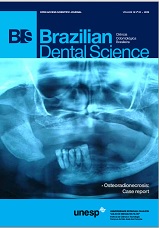Hemodynamic evaluation of normotensive and hypertensive patients undergoing dental extraction under local anesthesia with 3% prilocaine with felypressin
DOI:
https://doi.org/10.14295/bds.2015.v18i2.1117Abstract
Objective: this study evaluated hemodynamic variations of normotensive and hypertensive patients undergoing dental extraction under local anesthesia with 3% prilocaine with felypressin 0.03UI/ml. Material and Methods: 49 patients of the Department of Surgery and Maxillo-facial Traumatology ambulatory were evaluated, 30 normotensive and 19 hypertensive, presenting initial systolic blood pressure lower then 160 mmHg and diastolic blood pressure lower then 100 mmHg, besides being under medical supervision. Patients underwent molar or premolar extraction, typically deployed with maximum degree of mobility 2, according to Miller’s classification. The parameters evaluated were systolic and diastolic blood pressures and heart rate, using an automatic digital pulse device, in the following periods: T1 - initial (5 minutes before the beginning of surgery, T2 – post-anesthesia (2 minutes after anesthetic administration); T3 – trans-operatory (each 5 minutes after T2 until 20 minutes completition, totalyzing 4 trans-operatory mensurations); T4 – post-surgery (5 minutes after surgery). Results: statistical analysis showed that for the parameters systolic blood pressure (P = 0.959) and diastolic blood pressure (P = 0.754) no statistically significant difference for these parameters in different evaluation periods. The analysis of heart rate values showed no statistical difference (p <0.05) between the values obtained in T1 in hypertensive and normotensive patients in T3.3. Conclusion: it was concluded that the evaluated hemodynamic parameters varied in different periods evaluated in the group of normotensive and hypertensive patients, but did not differ significantly.
Downloads
Downloads
Additional Files
Published
How to Cite
Issue
Section
License
Brazilian Dental Science uses the Creative Commons (CC-BY 4.0) license, thus preserving the integrity of articles in an open access environment. The journal allows the author to retain publishing rights without restrictions.
=================




























